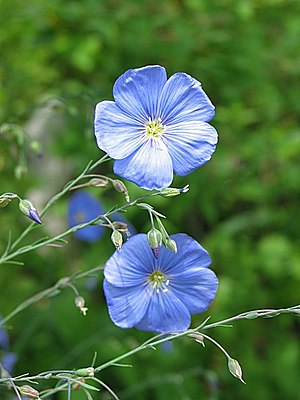Linseeds
| Linseeds | ||||||||||||
|---|---|---|---|---|---|---|---|---|---|---|---|---|

Common flax ( Linum usitatissimum ) |
||||||||||||
| Systematics | ||||||||||||
|
||||||||||||
| Scientific name | ||||||||||||
| Linaceae | ||||||||||||
| DC. ex Perleb |
The linaceae are a family in the order Malpighiae (Malpighiales) within the flowering plants (Magnoliopsida). The 10 to 16 genera with around 290 species are distributed almost worldwide from the permafrost zone to the tropics.
description

Appearance and leaves
The types of linseed are mostly herbaceous plants , more rarely woody plants: lianas , shrubs or, very rarely, trees .
The ever undivided, sessile leaves are alternate and usually arranged spirally or opposite. The leaf margins are smooth or serrated. They often have no stipules , if they are present then they are small.
Inflorescences and flowers
In zymos branched inflorescences differently structured partial inflorescences are combined.
The hermaphrodite flowers are radially symmetrical and usually five-fold with a double flower envelope . The five sepals are sometimes fused at the base. The five petals are free. There are one, two or very rarely three circles with five stamens each, part of which is often converted to staminodes . Two to five carpels have become a top permanent ovary grown.
Fruits and seeds
Many different fruit types are formed within this family (see subfamilies). The well-developed embryo is straight to slightly curved and has two large germ layers ( cotyledons ).
Systematics and distribution





The Linaceae family was established in 1818 by Augustin Pyrame de Candolle in Karl Julius Perleb : Experiment on the medicinal powers of plants , p. 107 under the name "Lineae". The type genus is Linum L. A synonym for Linaceae DC. ex Perleb is Hugoniaceae Arn.
The species of the Linaceae family thrive almost worldwide from the permafrost zone to the tropics .
The Linaceae are divided into two subfamilies, the Linoideae and the Hugonioideae. There are a total of about 10 to 16 genera with about 290 to 300 species:
- Subfamily Linoideae: The Linoideae are predominantly herbaceous plants with mostly narrow leaves and they only develop capsule fruits . It contains six to eight genera with about 240 species:
- Anisadenia Wall. ex Meisn. : Distributed with only two species from northeast India , Bhutan , Nepal , northern Myanmar , northern Thailand to China (both species).
-
Cliococca Bab. : It contains only one type:
- Cliococca selaginoides (Lam.) CMRogers & Mildner : It is distributed in southern South America and Brazil . It is also called Linum selaginoides Lam by some authors . placed in the genus Linum .
- Hesperolinone (A.Gray) Small : The 13 or so species only occur in California .
- Flax ( Linum L. ): The approximately 180 species are distributed almost worldwide from temperate to tropical areas; the center of biodiversity is the Mediterranean.
-
Radiola Hill : It contains only one species:
- Dwarf flax ( Radiola linoides Roth ): It is common in Eurasia and North Africa.
-
Reinwardtia Dumort. : It contains about two types, including:
- Reinwardtia indica Dumort. (Syn: Reinwardtia trigyna (Reichenb.) Planchon ): It is distributed from the Indian subcontinent via Laos, Myanmar, Thailand and Vietnam to China.
-
Sclerolinon C.M. Rogers : It contains only one type:
- Sclerolinon digynum (A.Gray) CMRogers : It is common in central and western America.
- Tirpitzia Hallier f. : It contains only three species in China (two species) and northeastern Thailand and Vietnam.
- Subfamily Hugonioideae Mabb. ex Reveal : The Hugonioideae (Syn .: Hugoniaceae Arn. ) are mostly woody plants that have quite broad leaves and develop a stone fruit or other fruit types. It contains four to eight genera with around 61 species:
- Hebepetalum Benth. : The three to six types are common in the Neotropic .
- Hugonia L .: The 15 to 32 species are common in the tropics.
- Indorouchera Hallier f. : Distributed with one to three kinds in Southeast Asia.
- Philbornea Hallier f. : The one to three species occur on Borneo and the Philippines .
- Roucheria planch. : The five to eight species are common in tropical South America.
swell
- The Linaceae family on the AP website . (Sections systematics and description)
- Linaceae at Tropicos.org. In: Flora of Pakistan . Missouri Botanical Garden, St. Louis
- Quanru Liu & Lihua Zhou: Linaceae , p. 34 - the same text online as the printed work , Wu Zheng-yi, Peter H. Raven & Deyuan Hong (Eds.): Flora of China , Volume 11 - Oxalidaceae through Aceraceae , Science Press and Missouri Botanical Garden Press, Beijing and St. Louis, 2008. ISBN 978-1-930723-73-3 (Description and key to identification of the Chinese taxa.)
- Description in the Western Australian Flora . (Section description)
- Description of the Linaceae family s. st. at DELTA. (English)
- Description of the Hugoniaceae family at DELTA. (English)
Individual evidence
- ↑ Linaceae at Tropicos.org. Missouri Botanical Garden, St. Louis, accessed August 5, 2014.
- ↑ a b c d Linaceae in the Germplasm Resources Information Network (GRIN), USDA , ARS , National Genetic Resources Program. National Germplasm Resources Laboratory, Beltsville, Maryland. Retrieved August 5, 2014.
Web links
- Linaceae at Tropicos.org. In: Catalog of the Vascular Plants of Madagascar . Missouri Botanical Garden, St. Louis
- Linaceae at Tropicos.org. In: Flora Mesoamericana . Missouri Botanical Garden, St. Louis
- Linaceae at Tropicos.org. In: IPCN Chromosome Reports . Missouri Botanical Garden, St. Louis
